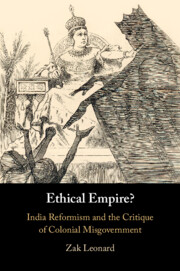Refine search
Actions for selected content:
4 results
4 - The Emerging State and the Constitution
-
- Book:
- Assembling India’s Constitution
- Published online:
- 24 September 2025
- Print publication:
- 09 October 2025, pp 164-200
-
- Chapter
- Export citation
Introduction
-
- Book:
- Ethical Empire?
- Published online:
- 05 October 2023
- Print publication:
- 19 October 2023, pp 1-21
-
- Chapter
- Export citation
Epilogue: Integrating the Empire
-
- Book:
- Ethical Empire?
- Published online:
- 05 October 2023
- Print publication:
- 19 October 2023, pp 251-264
-
- Chapter
- Export citation

Ethical Empire?
- India Reformism and the Critique of Colonial Misgovernment
-
- Published online:
- 05 October 2023
- Print publication:
- 19 October 2023
